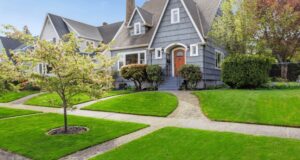Oakland, Chicago, Houston and Washington developments cited as national housing models
WASHINGTON – The U.S. Department of Housing and Urban Development (HUD) and the American Institute of Architects (AIA) today announced four model housing developments in California, Illinois, Texas and Washington State are the recipients of the 2016 HUD Secretary’s Housing and Community Design Award. Each of these developments are recognized for excellence in affordable or accessible housing design.
“Each of these developments are innovative housing opportunities offering seniors and families alike a place to thrive,” said HUD Secretary Julián Castro. “These winners prove that affordable and accessible housing can become part of the fabric of any neighborhood and reinforce the principles of inclusiveness and opportunity.”
The new HUD Secretary’s Housing and Community Design Award recipients are:
Excellence in Affordable Housing Design Award – This award recognizes architecture that demonstrates overall excellence in terms of design in response to both the needs and constraints of affordable housing.

Located in a prime neighborhood on the banks of Oakland’s Lake Merritt, this building is now home to 91 very-low-income and special-needs homeless seniors, many of whom have been displaced with the Bay Area’s rapidly rising housing costs. The building has extensive on-site services and is designed to support independent living, with strong transit connections to downtown Oakland and San Francisco and access to amenities, including a pharmacy and grocery. The high-density housing—138 units per acre—provides indoor and outdoor community spaces at both the ground floor and upper levels. The central west-facing main courtyard opens visually toward the street and is warmed by afternoon sun. A rooftop suite of community spaces overlooks the lake, maximizing views for the most users. Designed with a complementary series of sustainable strategies, the building is pending receipt of LEED for Homes Mid-Rise Platinum Certification.
The ground-floor community room includes a kitchen and TV lounge as well as space for activities—from art programs to monthly resident town hall meetings. This community space opens widely to the courtyard, creating a flexible indoor-outdoor plaza. The private space offers views to the neighborhood and is visible to passersby, balancing security and transparency and connecting the building to the life of the larger neighborhood. The two building masses connect across the courtyard at the upper levels via sunny bridges with neighborhood and lake views. A fifth-floor suite of community spaces includes rooftop garden plots for residents, a community room and kitchen, outdoor decks, and a wellness studio—used for stretching and tai chi sessions. This suite overlooks the lake, maximizing views for the greatest number of users. The in-progress art program is a partnership with a local nonprofit gallery that supports developmentally disabled artists. Artworks are licensed and reproduced at a large scale, creating pieces that are appropriate to the large common areas on an accessible budget.
____________________________________
Creating Community Connection Award – This award recognizes projects that incorporate housing within other community amenities for the purpose of either revitalization or planned growth.
Dorchester Art + Housing Collaborative (DA+HC), a 32-unit mixed housing development and vibrant arts and cultural hub for Chicago’s Greater Grand Crossing neighborhood, has transformed Dante Harper townhouses which werebuilt by the Chicago Housing Authorityin the early 1980’s and vacated in 2007. The project embodies a successful collaboration between private, public, and non-profit sectors committed to transforming the Greater Grand Crossing neighborhood through the reactivation of abandoned buildings and cultural foundations. DA+HC comprises 32 of the original 36 two- and three-bedroom townhouse units; the four center units were removed to create a 2,200 square foot Arts Center complete with a dance studio, work and tech shops, and public meeting space. The Arts Center and adjacent landscaped courtyard function as a community hub and support a variety of programs, including a life-planning class, a neighborhood ensemble band, and a weekly gathering of residents to brainstorm strategies for improving the area. The DA+HC supports programs from outside organizations and institutions, such as the South Shore Fine Arts Academy and the Joffrey Ballet. In addition, the DA+HC is within close proximity to other cultural sites, such as Black Cinema House and Stony Island Arts Bank.
With an even distribution of low-income, affordable, and market rate units, 72% of the occupants are at or below 80 percent of area median income. To foster dialogue and collaboration between artists and community members, DA+HC is the first in the nation to provide artist residences in public housing. The artists living onsite volunteer their time to develop programming and catalyze neighborhood revitalization through artistic practice, individual empowerment, and community engagement. Four units were gutted and converted into flat configurations to achieve accessibility compliance. Renovation was designed to Energy Star standards with energy-efficient windows, doors, lighting, and appliances, a super-insulted building shell, and air quality and resource conservation. Stormwater is stored onsite by way of green roofs, rain gardens, and permeable pavers. When possible, materials were reused from the original building and incorporated into railings and cabinetry. With an 18% unemployment rate, 25% of the population below the poverty line, and ranked 5th among violent crimes in Chicago neighborhoods, the project is intended to stimulate a community revitalization that is culturally-based, artist-led, and neighborhood-driven. Financing included Low Income Housing Tax Credits, state Donation Tax Credits, a Chicago Housing Authority loan, and a grant from the Federal Home Loan Bank of Chicago.
____________________________________
Community-Informed Design –This award recognizes design that supports physical communities as they rebuild inner city social structures and relationships that may have been weakened by outmigration, disinvestment, and the isolation of inner city areas.
Disaster Recovery Round 2 (DR2) in Houston was launched five years after Hurricane Ike devastated the Texas Gulf Coast to fill the gap in home repair and replacement and offer homeowners choice in their disaster recovery experience. It brought together design expertise of local design architects and insight from residents directly affected by the storm to build single family high quality cost-effective sustainable houses that respect community interests and character. Six target neighborhoods (called Community Revitalization Areas or Outreach Areas) in the City of Houston were engaged through several public events which offered opportunities for a diverse group of residents, community leaders, city staff and local designers to provide direct input. The design team gathered information about each neighborhood from demographic research and documentation of neighborhood form and character. Following initial research, engagement events included a workshop, a focus group, and gallery shows that collected input from more than 300 neighborhood residents.
Each of the engagements generated a report of resident commentary, activity results, and analysis that provided guidelines for local design architects to refine their home designs. To address the housing needs on a multi-neighborhood scale, the vetted home designs were compiled into a catalogue to provide options for family-based design development and construction. Home designs were then approved and permitted by the City, and individual homeowners were scheduled to meet with design team representatives. Homeowners were provided a selection of catalogue designs based on neighborhood preferences and site considerations. They were then walked through each of the design options to help them select a house that met their needs and preferences. To date, over 260 homeowners have met with the design team to select a home from the catalogue. The approach to DR2 created a collaborative relationship with the city, residents, and local designers. This ensured the process supported local professionals as well as benefited residents, and home designs were appropriate to the communities in which they were placed and have the versatility to meet the needs of their residents.
____________________________________
For Housing Accessibility – Alan J. Rothman Award – The purpose of this award is to recognize exemplary projects that demonstrate excellence in improving housing accessibility for people with disabilities.
Port Townsend Residence in Port Townsend, Washington is a modest home on a small level lot in a small community arranged around a common garden space which was built to accommodate a couple, one of whom uses a power wheelchair. The house offers an accessible route from the street through the house to the terrace and on to the common garden space, thus expanding the effective living space and to facilitating daily strolls in the neighborhood. For longer trips, the husband uses an accessible van. The attached carport accommodates the van with its ramp, creating a covered accessible route from the front entrance into the van.
An open plan facilitates circulation of a power wheel chair within a modest footprint. The telescoping doors to the bedrooms allow the owners choice in how to use the rooms and how connected they are to the living spaces. To facilitate use with limited dexterity, pocket doors have large panel-mounted handles which do not disappear entirely into the wall. The house is constructed with a Douglas fir timber frame enclosing Structural Insulated Panels (SIPs). SIPs offer continuous insulation and fewer pathways for air infiltration than standard stick frame construction, resulting in a tight, energy efficient assembly. Tall windows on the south side of the house gather passive solar energy. The entry door and sidelight feature vertical glazing to allow viewing of the external approach from any height. The kitchen can be used from both a standing position and from a wheelchair. Knee space is provided beneath the sink. A pot filler faucet on the cooktop reduces the need to carry heavy pots. A wall oven and a wall-mounted microwave oven keep the oven racks within the proper reach range. Base cabinets fitted with drawers and a floor-to-ceiling cupboard maximizes shelving within the reach range of a wheelchair user. The bathrooms have knee space beneath the vanity. A Universal height toilet serves both users. The threshold-free shower uses a linear drain. Towel bars and the adjustable shower head bar are built and anchored as grab bars, so that any of them can be relied upon in a fall. Two sets of shower valves and heads in each shower allow use by both owners without readjustment. Wire baskets, rather than recesses, are provided to restrain shampoo bottles and soap from falling until they can be securely grasped.
###
HUD’s mission is to create strong, sustainable, inclusive communities and quality affordable homes for all.
More information about HUD and its programs is available on the Internet
at www.hud.gov and http://espanol.hud.gov.
You can also connect with HUD on social media and follow Secretary Castro on
Twitter and Facebook or sign up for news alerts on HUD’s Email List.
Brian Sullivan
(202) 708-0865













